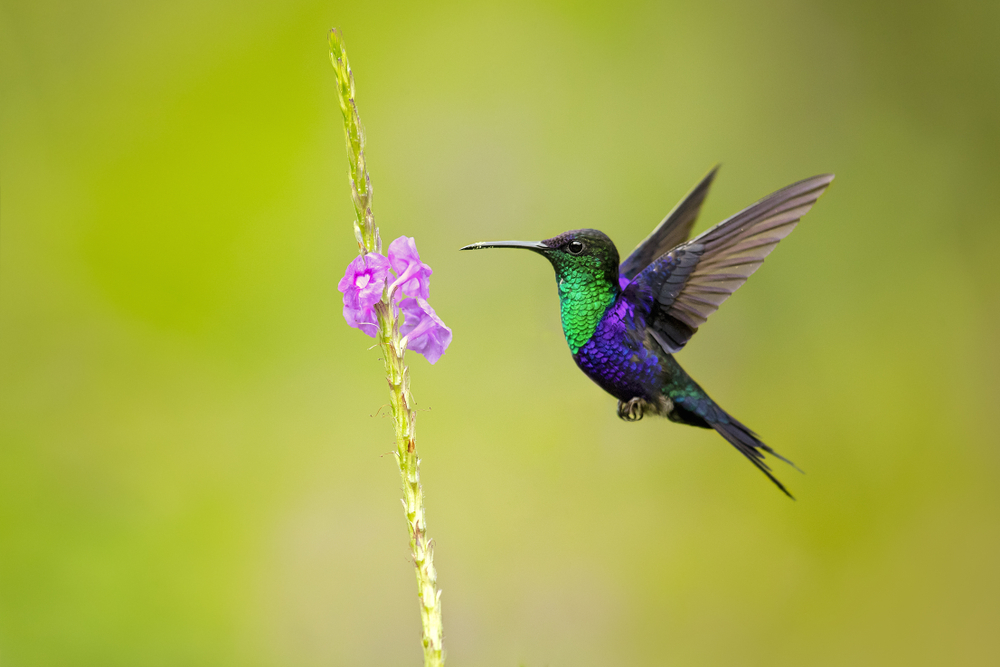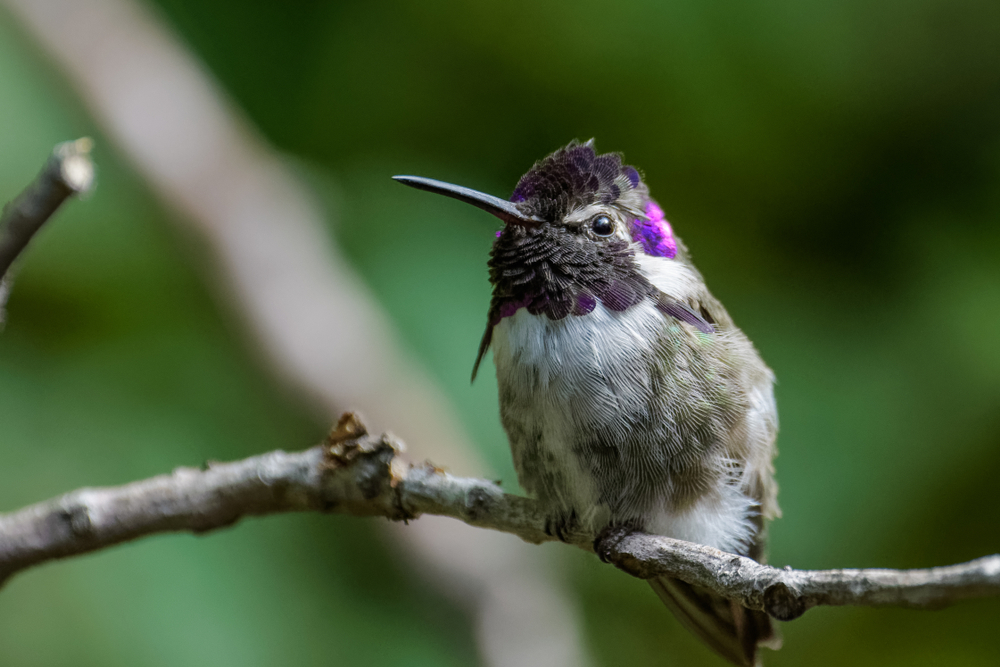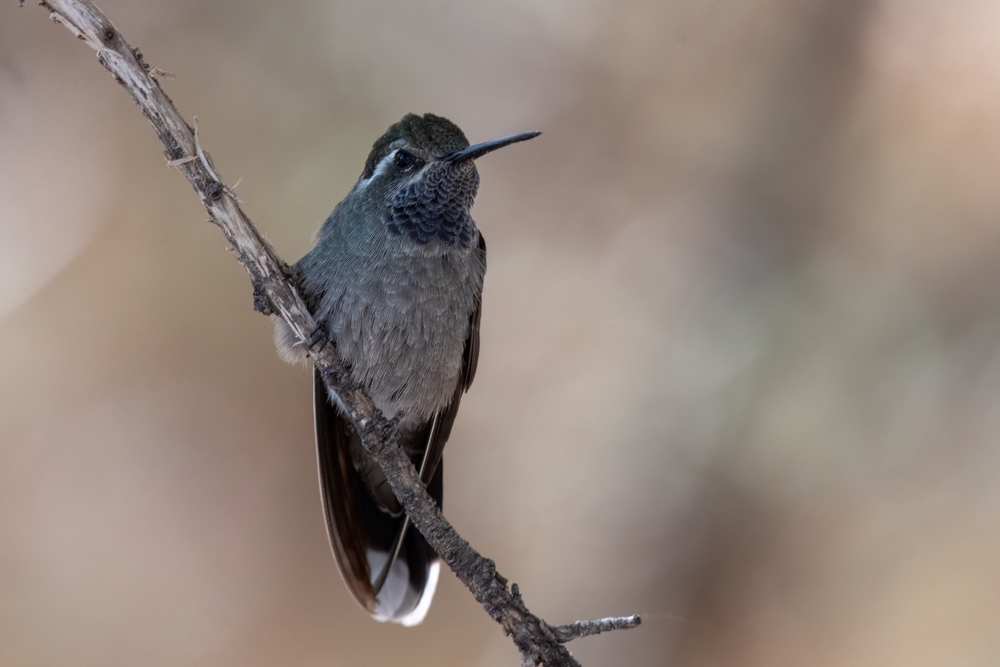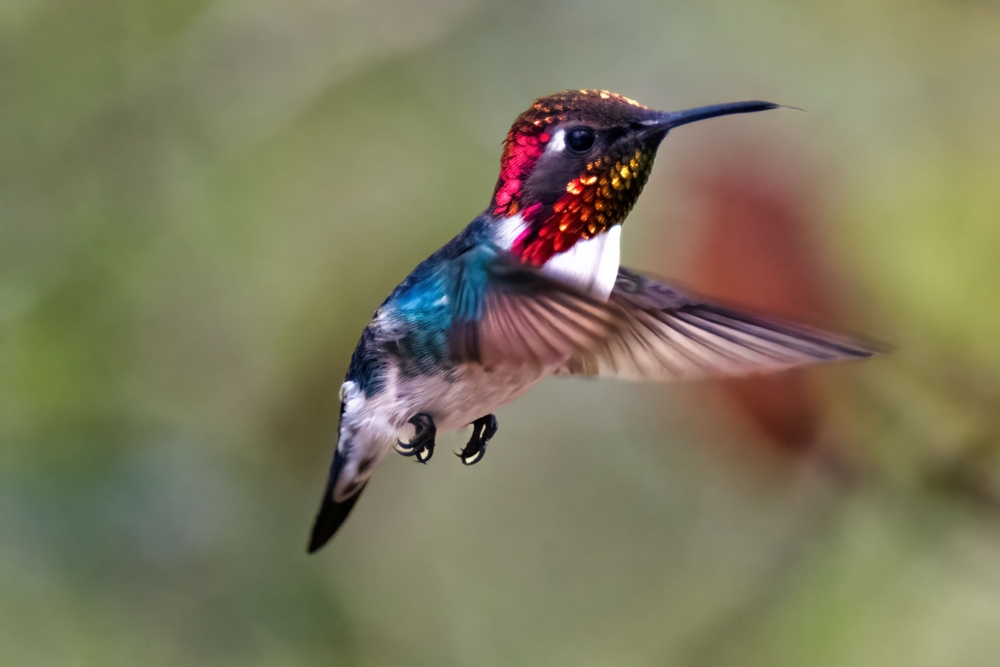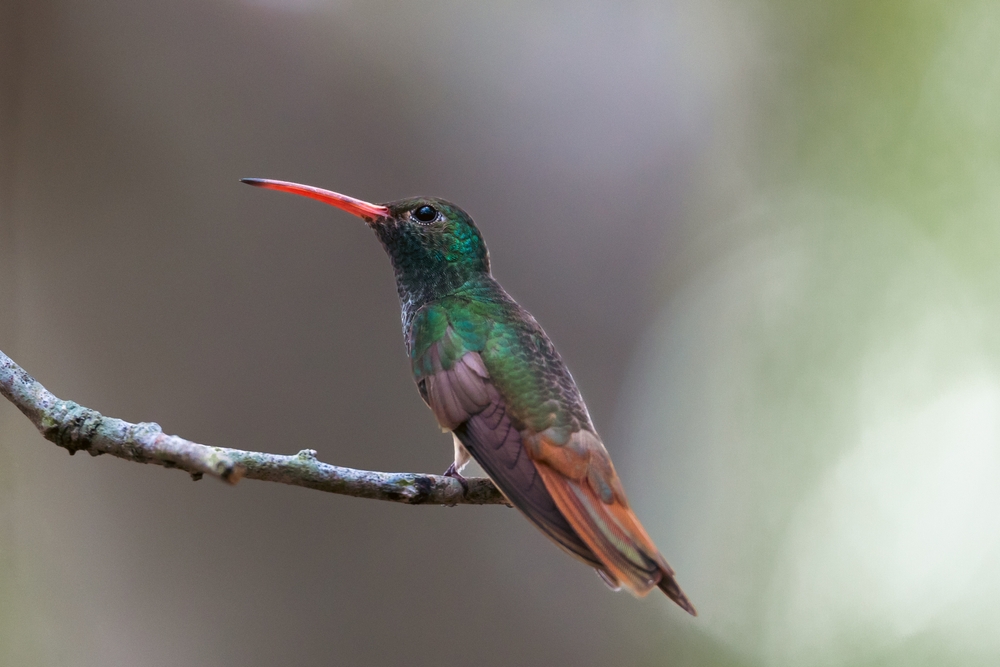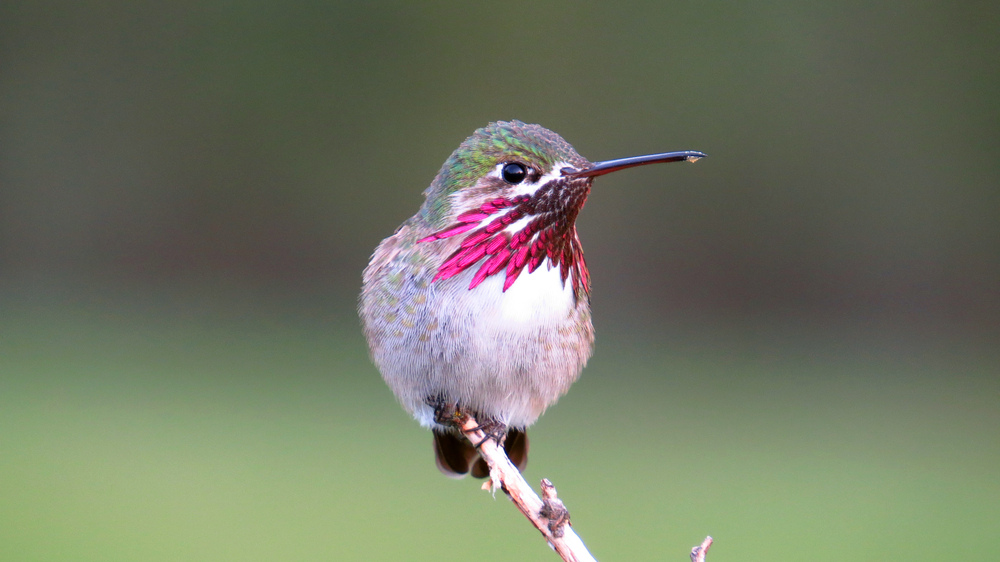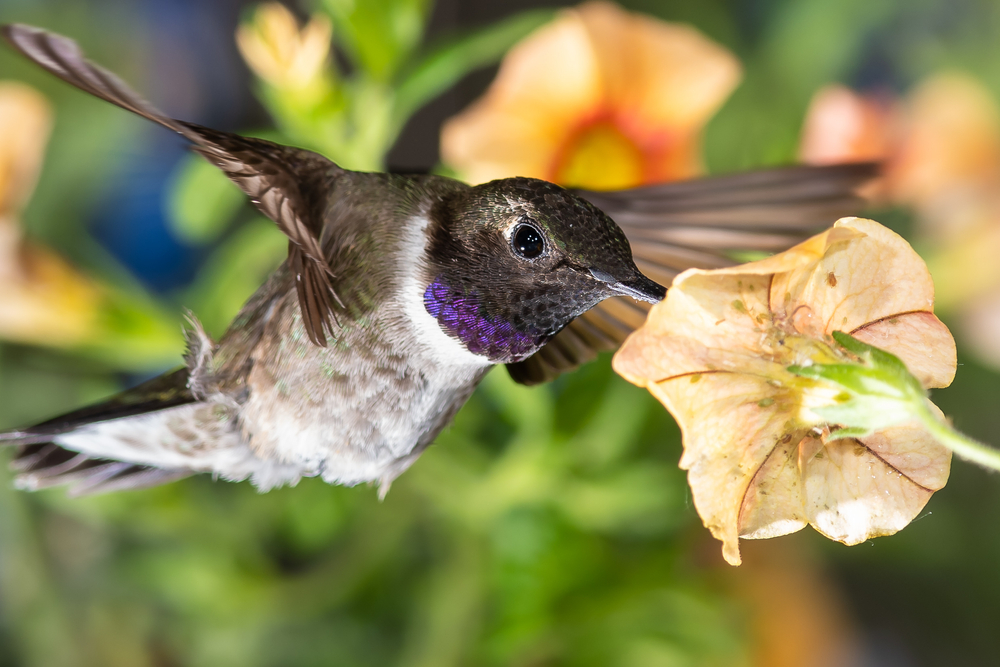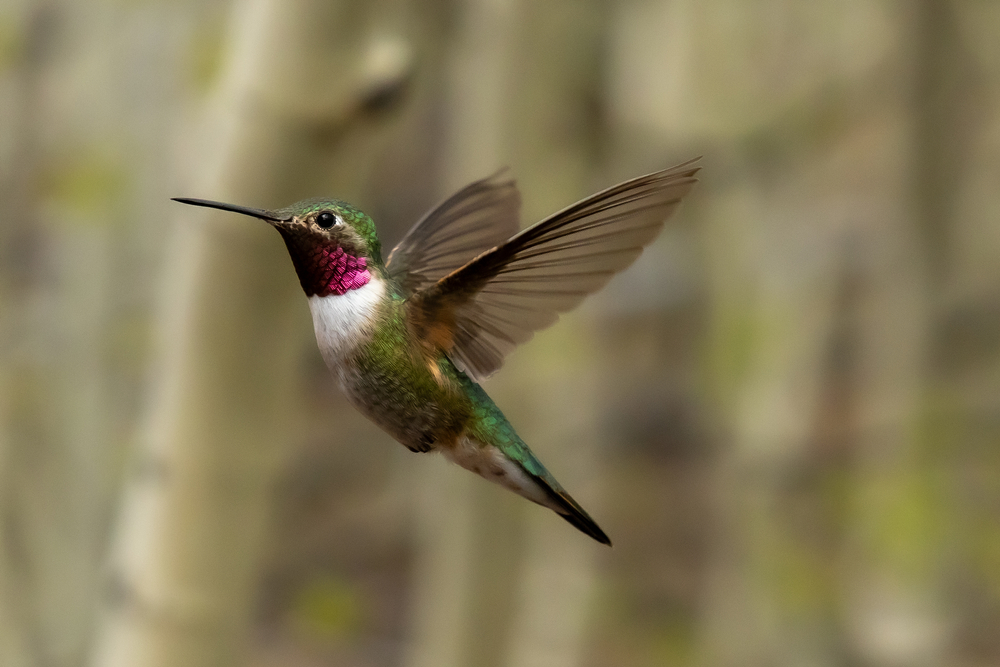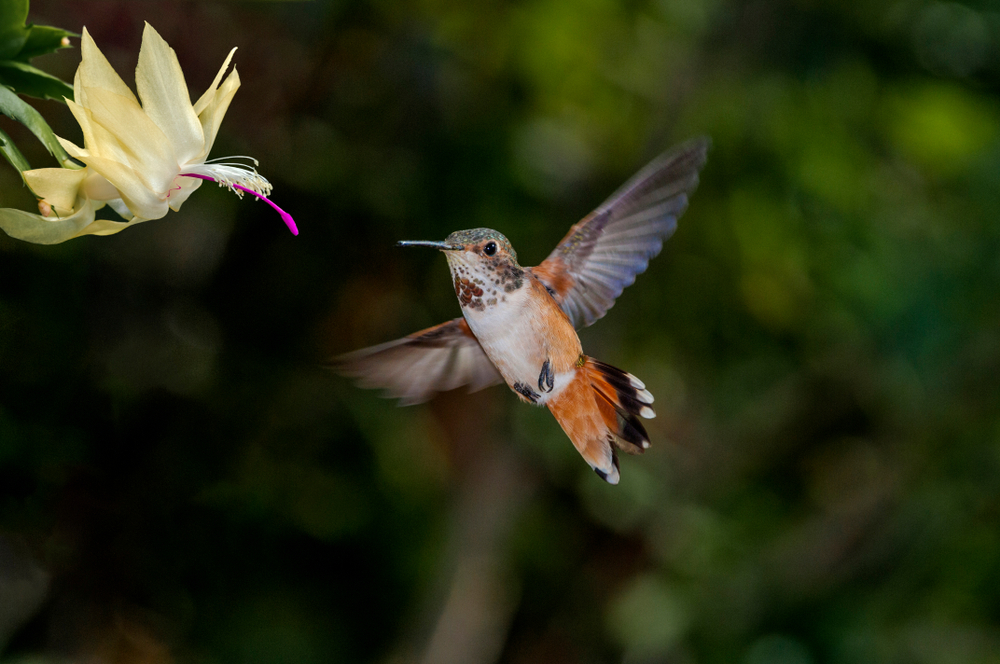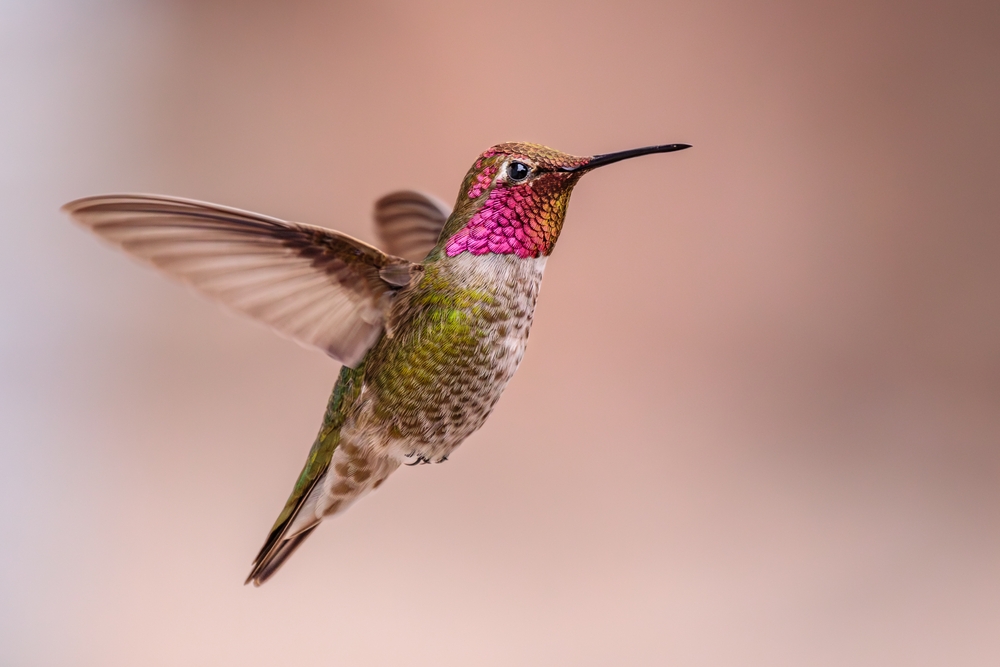The Green Violet-ear (Colibri thalassinus) is most closely related to other members of the Colibri genus, particularly the Sparkling Violet-ear (Colibri coruscans), which is larger and has an even more intense violet throat and ear patches.
About
The Mexican Violetear (Colibri thalassinus), also known as the Green Violet-ear, is a vibrant and wide-ranging hummingbird belonging to the family Trochilidae. Found from Mexico through Central America and into the Andes of South America, it inhabits montane forests, forest edges, and clearings, often at elevations between 1,200 and 2,400 meters (4,000–8,000 ft). It is one of the more conspicuous hummingbirds in its range, frequently visiting flowering shrubs and feeders, and sometimes forming loose groups in areas rich in nectar.
This medium-sized hummingbird measures about 9.5–12 cm (3.7–4.7 in) in length and weighs 4.5–6 grams. True to its name, it is cloaked in brilliant metallic green plumage, with a distinctive violet-blue patch (the “violet ear”) running from the sides of the head down the neck. The tail is slightly forked and tipped with blue-black, complementing its shimmering body. Both sexes are similar in appearance, though males tend to be more vividly colored.
The Mexican Violetear feeds primarily on nectar, often favoring tubular flowers of shrubs and trees. Its long bill and hovering ability allow it to reach deep into blooms, and like many hummingbirds, it also supplements its diet with small insects and spiders for protein. Unlike some more solitary hummingbirds, this species is known for its somewhat gregarious nature, often gathering in feeding flocks where flowers are abundant. Males are territorial, however, and defend rich nectar sources aggressively.
Breeding habits vary across its wide range, but the female alone builds a small cup-shaped nest of plant fibers, moss, and spider silk, camouflaged with lichens. She lays two small white eggs and raises the young without assistance from the male.
Though widespread and common, the Green Violet-ear depends on healthy montane forests. Its dazzling colors, violet ear patch, and lively presence make it a favorite among birdwatchers across Latin America.
Physical Characteristics
Plumage:
The Green Violet-ear (Colibri thalassinus), also known as the Mexican Violet-ear, is a medium-sized, vibrantly colored hummingbird.
-
Male & Female (similar): Overall brilliant metallic green plumage with a glowing violet-blue patch (“ear”) on the sides of the head that gives the species its name.
-
A bold violet band runs across the upper chest, contrasting with the green body.
-
Wings are dusky with green highlights, and the tail is slightly notched, mostly dark blue with a black band near the end.
Head:
The metallic green crown blends into the rest of the plumage, with the violet “ear” patch as a distinctive field mark. The bill is straight, slender, and black, perfectly suited for nectar feeding.
Body:
Sleek and medium-sized for a hummingbird, with shimmering iridescence across its body. Both sexes are nearly identical, making this species less sexually dimorphic than many other hummingbirds.
Size:
-
Length: 4.3–4.7 in (11–12 cm)
-
Wingspan: About 5.1–5.5 in (13–14 cm)
-
Weight: 0.17–0.20 oz (4.8–5.6 g)
Feet & Tail:
Feet are very small, adapted mainly for perching. The tail is notched, dark blue with a black subterminal band, sometimes showing faint green iridescence.
Flight Style:
Wingbeats average 50–60 per second, allowing precise hovering. Males are often aggressive, chasing away rivals with rapid aerial pursuits.
The Green Violet-ear’s violet “ear” patches, shimmering green body, and chest band make it one of the most spectacular and unmistakable hummingbirds of Central and South America.
Reproduction
Breeding Season:
The Green Violet-ear breeds mainly during the rainy season, when flowers are most abundant. Timing varies across its wide range, but in Central America it often occurs between April and August.
Courtship:
-
Males gather in small leks (display areas) where they sing, hover, and flash their iridescent plumage to attract females.
-
The violet-blue “ear” patches and chest band are shown off during hovering displays.
-
As with most hummingbirds, males do not participate in nesting or chick-rearing after mating.
Nesting:
-
The female alone builds the nest, usually 3–15 ft (1–5 m) above ground in trees, shrubs, or on sheltered ledges.
-
The nest is a tiny cup-shaped structure, made of plant fibers, moss, and spider silk for elasticity, and camouflaged with lichens and bark fragments.
Eggs:
-
A clutch contains 2 small white eggs, each about the size of a pea (~0.5 in / 1.3 cm long).
Incubation:
-
Lasts 14 to 16 days.
-
The female alone incubates the eggs.
Chick Development:
-
Hatchlings are altricial (blind, featherless, and helpless).
-
The female feeds them regurgitated nectar mixed with insects for protein.
-
Nestlings fledge at about 20 to 23 days, though they may continue to receive food from the mother briefly after leaving the nest.
Maturity:
-
Juveniles begin foraging independently soon after fledging.
-
Sexual maturity is typically reached at about 1 year of age.
The Green Violet-ear’s reproductive cycle reflects its dependence on flowering peaks during the rainy season and the female’s complete responsibility for raising the young.
Lifespan
In the Wild:
Mexican Violetears typically live 4 to 6 years in their native montane and cloud forest habitats of Central and South America. As with most hummingbirds, many do not survive their first year due to predation and the challenges of migration or resource competition.
In Captivity:
Though rarely kept, individuals in rehabilitation or protected care can live longer, sometimes reaching 8 to 9 years with consistent food and no predation.
Record Lifespan:
The oldest recorded Green Violet-ear, documented through banding studies, lived at least 8 years and 5 months.
Threats to Longevity:
-
Predation: Vulnerable to hawks, snakes, larger birds, and arboreal mammals; eggs and chicks are often taken by lizards or ants.
-
Habitat Loss: Deforestation of montane forests reduces feeding and nesting opportunities.
-
Competition: Aggressive larger hummingbirds may displace them from preferred nectar sources.
-
Climate Change: Alters flowering cycles in cloud forests, which can disrupt their food supply.
Despite these pressures, Green Violet-ears remain widespread and adaptable, often thriving in disturbed habitats, forest edges, and even gardens at mid- to high elevations.
Eating Habits
Diet:
The Mexican Violetear feeds primarily on:
-
Nectar: Its main energy source, taken from a wide variety of flowers, including bromeliads, passionflowers, salvias, and other tubular blossoms.
-
Insects & Spiders: Small flies, gnats, aphids, and spiders provide protein, especially for chicks.
-
Sap: Occasionally visits sapsucker wells to drink tree sap and catch insects trapped in it.
Foraging Behavior:
-
Uses its slender, straight bill and long brush-tipped tongue to lap nectar at high speed (10–13 licks per second).
-
Often forages in the forest canopy and edges, though it also visits gardens and open areas with flowering plants.
-
Known for being aggressive and territorial, males frequently chase away rivals at nectar-rich patches.
-
Will supplement diet by hawking insects midair or gleaning them from leaves and webs.
Feeding Adaptations:
-
Wingbeats average 50–60 per second, allowing them to hover precisely while feeding.
-
Excellent memory allows them to track the renewal rate of individual flowers.
-
Enter torpor at night to conserve energy in cooler highland environments.
Role in Ecosystem:
The Green Violet-ear is an important pollinator of montane and cloud forest plants, transferring pollen between flowers while feeding. By also consuming insects, it contributes to controlling small insect populations.
The Green Violet-ear’s nectar specialization, aggressive defense of feeding sites, and pollinator role make it a keystone hummingbird in highland ecosystems.
Uniqueness
Violet “Ears”:
One of the few hummingbirds with distinct violet-blue patches on the sides of the head, which inspired its name. These markings flash brightly when the bird is alert or displaying.
Violet Breast Band:
In addition to the ear patch, a bold violet chest band sets it apart from most other hummingbirds, making males and females equally colorful.
Less Sexual Dimorphism:
Unlike many hummingbirds with stark male-female differences, both sexes of the Green Violet-ear are similarly iridescent, making this species less dimorphic than most.
Aggressive & Nomadic:
Known for its aggression at feeders and flower patches, often chasing away rivals, even larger hummingbirds. Some populations are also seasonally nomadic, moving with flowering cycles rather than fixed migrations.
Wide Elevation Range:
This species thrives from lowland forests to high-altitude cloud forests (up to 10,500 ft / 3,200 m), showing greater elevation tolerance than most hummingbirds.
Voice & Singing:
Males are unusually vocal for a hummingbird, often singing persistent, musical notes from exposed perches to defend territories.
The Green Violet-ear’s violet facial and breast patches, reduced sexual dimorphism, nomadic habits, and unusual vocalizations make it one of the most distinctive hummingbirds of Central and South America.
Be the First to Share Photos of This Species.
FAQ’s
1. What is the closest species to the Mexican Violetear?
2. How does the Mexican Violetear compare to other hummingbirds?
Unlike many hummingbirds that show strong male-female differences, Mexican Violetears are similarly iridescent in both sexes. They are also more vocal, with males singing persistently to defend feeding territories—behavior uncommon in most hummingbirds.
3. What national parks provide the best opportunities to see a Mexican Violetear?
They are best observed in highland parks and reserves such as Monteverde Cloud Forest Reserve (Costa Rica), Podocarpus National Park (Ecuador), and La Amistad International Park (Costa Rica & Panama), where flowering trees attract them in abundance.




































































